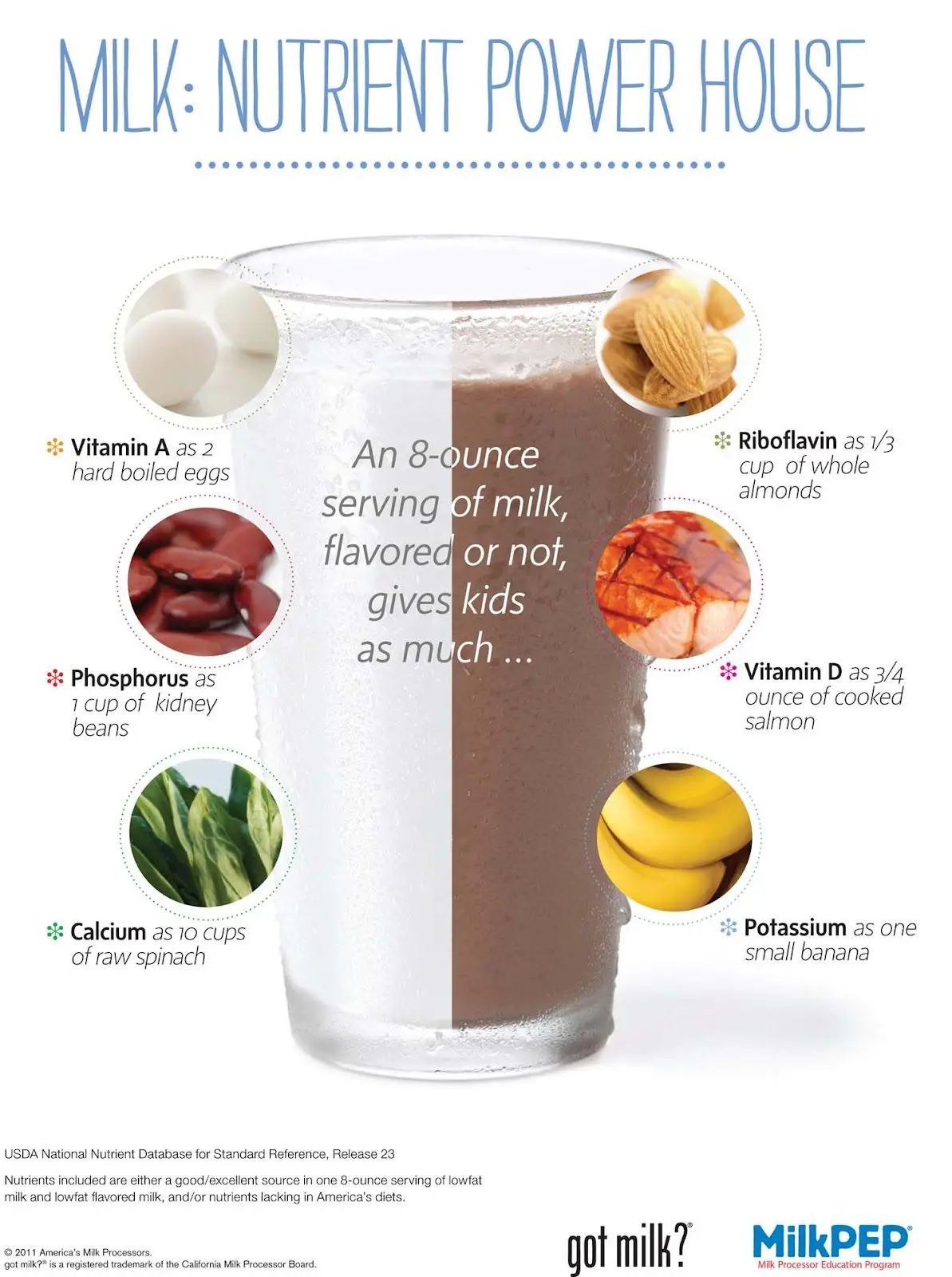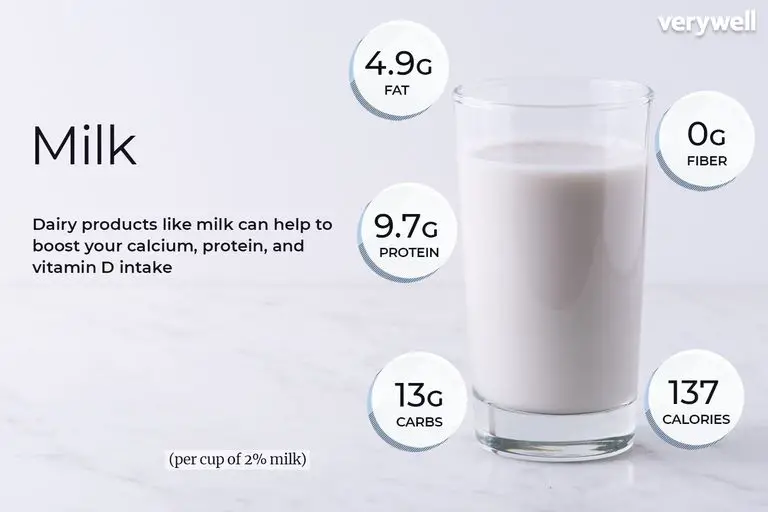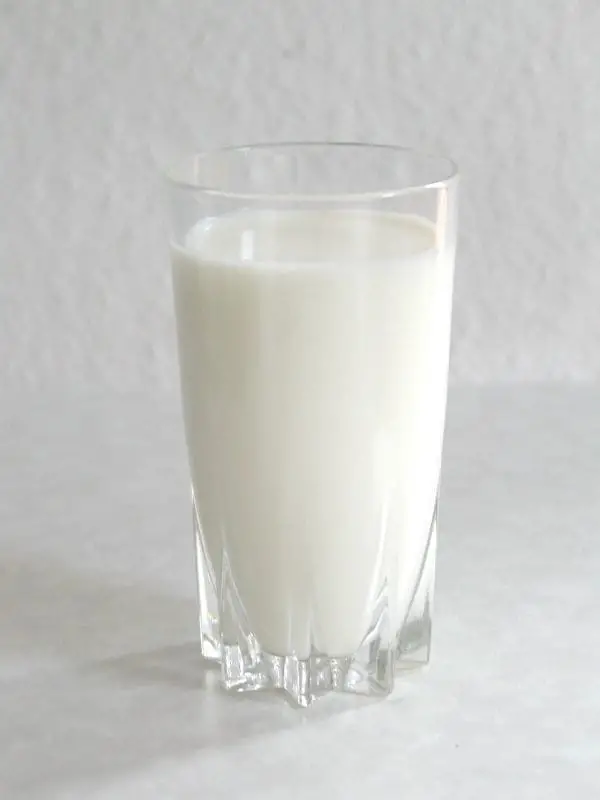What Other Food Products Have Vitamin D
As weve highlighted already, milk is an excellent source of vitamin D. Its also affordable, accessible, and full of other nutrients as well, such as calcium.
Since each serving of milk only contains about 100 to 180 IU of vitamin D, youll probably need additional food sources to meet the daily recommended 600-800 IU intake .
Experts agree a varied diet rich in foods with vitamin D is the best way to ensure youre meeting the daily requirement. Here are some everyday food products and how much vitamin D each contains :
- Cod liver oil, one tablespoon: 1,360 IU
- Salmon , cooked, three ounces: 570 IU
- Trout , farmed, cooked, three ounces: 645 IU
- Mushrooms, white, raw, sliced, exposed to UV light, ½ cup: 366 IU
- Egg, one large, with yolk: 44 IU
- Liver, beef, braised, three ounces: 42 IU
- Tuna fish , canned in water, drained, three ounces: 40 IU
- Sardines , canned in oil, drained, two sardines: 46 IU
- Cheese, cheddar, one ounce: 12 IU
- Ready-to-eat cereal fortified with vitamin D, one serving: 8 IU
What Types & How Much Vitamin D Is In Milk
Most milk sold at retail in the U.S. contains vitamin D. Because few foods naturally contain vitamin D, it can be added in specified amounts to foods like milk, yogurt and many cheeses to help people meet dietary recommendations.. Vitamin D fortified milk must contain at least 100 International Units and up to a maximum of 150 IU vitamin D per eight-ounce serving per national milk standards.
Understanding The Recommended Vitamin D Levels
The only way to measure vitamin D levels is to have a blood test, either at a doctors office or a laboratory. How much vitamin D you need every day depends on your age. Average daily recommended amounts from the Food and Nutrition Board at the Institute of Medicine for different ages are listed below in International Units :
Don’t Miss: What Vitamins Should I Take Daily For A Woman
Why Is Cow Milk Bad For You
It can carry harmful pathogens, including salmonella and E. coli, and many infants and children are allergic to it, though some outgrow their allergy. And many adults are lactose-intolerant, meaning they lack enough of a digestive tract enzyme critical to processing lactose-laden foods such as cows milk.
Food Product For Humans

In many cultures, especially in the West, humans continue to consume milk beyond infancy, using the milk of other mammals as a food product. Initially, the ability to digest milk was limited to children as adults did not produce lactase, an enzyme necessary for digesting the lactose in milk. People therefore converted milk to curd, cheese and other products to reduce the levels of lactose. Thousands of years ago, a chance mutation spread in human populations in Europe that enabled the production of lactase in adulthood. This mutation allowed milk to be used as a new source of nutrition which could sustain populations when other food sources failed. Milk is processed into a variety of products such as cream, butter, yogurt, kefir, ice cream, and cheese. Modern industrial processes use milk to produce casein, whey protein, lactose, condensed milk, powdered milk, and many other food-additives and industrial products.
Per capita consumption of milk and milk products in selected countries in 2011| Country |
|---|
You May Like: What Type Of Vitamin D Should I Take
What Are The Benefits Of Vitamin D
Vitamin D works in concert with calcium to help build and maintain strong bones. Getting enough vitamin D helps to protect children from rickets and older adults from osteoporosis.
Vitamin D is important to the body in many other ways as well. Muscles need it to move, for example, and nerves need it to carry messages between the brain and every body part. In addition, a growing body of evidence supports the potential benefits of vitamin D. For example, it may help to reduce the risks of high blood pressure, diabetes, cardiovascular disease and cancer, according to the Dietary Guidelines Advisory Committee Report .
In Language And Culture
The importance of milk in human culture is attested to by the numerous expressions embedded in our languages, for example, “the milk of human kindness”, the expression “there’s no use crying over spilt milk” , “don’t milk the ram” and “Why buy a cow when you can get milk for free?” .
In Greek mythology, the Milky Way was formed after the trickster god Hermes suckled the infant Heracles at the breast of Hera, the queen of the gods, while she was asleep. When Hera awoke, she tore Heracles away from her breast and splattered her breast milk across the heavens. In another version of the story, Athena, the patron goddess of heroes, tricked Hera into suckling Heracles voluntarily, but he bit her nipple so hard that she flung him away, spraying milk everywhere.
In many African and Asian countries, butter is traditionally made from fermented milk rather than cream. It can take several hours of churning to produce workable butter grains from fermented milk.
Holy books have also mentioned milk. The Bible contains references to the “Land of Milk and Honey” as a metaphor for the bounty of the Promised Land. In the Qur’an, there is a request to wonder on milk as follows: “And surely in the livestock there is a lesson for you, We give you to drink of that which is in their bellies from the midst of digested food and blood, pure milk palatable for the drinkers” . The Ramadan fast is traditionally broken with a glass of milk and dates.
You May Like: How To Get All My Vitamins And Minerals
Top 10 High Vitamin D Foods
Vitamin D is an essential vitamin required by the body for the absorption of calcium, bone development, immune functioning and alleviation of inflammation.
A deficiency of Vitamin D can lead to rickets, a weakened immune system, increased cancer risk, poor hair growth and osteomalacia.
Excess vitamin D can cause the body to absorb too much calcium, leading to increased risk of heart disease and kidney stones.
The current U.S. Daily Value for vitamin D is 20g and the toxicity threshold is thought to be 250 to 1000 g/day.
Sometimes vitamin D values are given in IU . When this is the case remember that 1g=40IU for Vitamin D.
Vitamin D is fat soluble, which means you need to eat fat to absorb it. Foods high in vitamin D include fish, mushrooms exposed to sunlight, fortified milk, fortified milk substitutes, fortified tofu, fortified yogurt, fortified breakfast cereals, fortified orange juice, pork chops, and eggs.
Vitamin D is also made by the body when skin is exposed sunlight and is therefore called the sunshine vitamin. This accounts for approximately 90% of our total vitamin D, with only 10% coming from food. Depending on where you live, 20 minutes of sun exposure a day is enough to meet your vitamin D requirements.
Below is a list of the top 10 foods highest in vitamin D by common serving size, for more see the nutrient ranking of 200 foods high in vitamin D.
Milk Is It Enough To Maintain A Healthy Vitamin D Level
How much vitamin D is in a glass of milk? One 8-oz glass of vitamin D fortified milk has approximately 100 IU of vitamin D. This is 1/6 of the current Recommended Daily Allowance , which is, in turn, an order of magnitude of what your body really needs. Research has shown that it takes about 4,000 IU/day to get 95% of the population to the …
Don’t Miss: When Is The Best Time To Take Centrum Vitamins
How Do You Know If You Have Low Vitamin D
Symptoms of vitamin D deficiency can include muscle weakness, pain, fatigue and depression. To get enough D, look to certain foods, supplements, and carefully planned sunlight.Signs and symptoms might include: Fatigue. Bone pain. Muscle weakness, muscle aches, or muscle cramps. Mood changes, like depression.
Functions Of Vitamin A
You might know that vitamin A helps maintain the health and function of your eyes, but the nutrient does much more than that, too. Vitamin A plays a role in the health of your skin and soft tissues and also supports strong bones and teeth. You need plenty of vitamin A to make white blood cells, which help you fight off infections. The vitamin also acts an antioxidant, which means it helps protect your cells from damage that can cause chronic health problems such as cardiovascular disease and cancer.
Also Check: What Vitamins Are Good For Energy And Weight Loss
Can Vitamin D Boost Fertility
Did you know? Sunlight can actually boost fertility, according to new research. The findings claim that vitamin D can balance sex hormones in women and further improve sperm count in men, with the conclusion suggesting some couples could be undergoing unnecessary and costly fertility treatments when spending time in the sunshine could prevent the need for them.
The researchers at the Medical University of Graz in Austria found that women ovulate less and their eggs have a reduced chance of implanting in the womb in the winter months. The vast majority of people in this country around 86 per cent are getting less than the optimum levels, says Oliver Gillie, director of the Health Research Forum.
Does Vitamin D Affect The Pill

Speaking about fertility, one study found that being on the contraceptive pill can increase your levels of vitamin D by up to 20%. Its not as much as the 50% to 70% that a supplement offers, but is especially good news for women in the UK where, according to Public Health England, one in five British adults are not getting enough vitamin D due to the lack of bright sunshine here.
This information is particularly important if youre looking to conceive. If a woman already has low vitamin D levels, coming off the pill may cause a potentially harmful drop to an even lower level. Vitamin D is important for both you and your baby, as its needed for foetal skeletal growth so check with your doctor whether you need to take extra supplements and its worth considering upping your intake of the below Vitamin D foods, as well.
Recommended Reading: What Vitamins Do You Need When Pregnant
Do Men Need A Vitamin D Supplement
The NHS recommends that adult men and women take 10 micrograms/400 IU of vitamin D supplements each day between October and March. Vitamin D tends to come in tablet form that you swallow or dissolve in water. It can also come in a spray or drop form, but this may be harder to administer in the right dose.
Calcium And Vitamin D
Dairy products are good sources of calcium. An 8-ounce glass of milk contains about 300 mg of calcium. Two slices of firm cheeses, such as American, Swiss, cheddar or mozzarella have about as much calcium as a glass of milk. Softer cheeses, like cottage cheese, most often contain 1/3 to 1/2 this amount of calcium per serving. Other calcium-rich foods are yogurt, salmon, tofu, almonds
Also Check: How Much Is A Megadose Of Vitamin C
How To Get Vitamin D Through Sunlight
Regular sun exposure is the most natural way to get enough vitamin D. To maintain healthy blood levels, aim to get 1030 minutes of midday sunlight, several times per week. People with darker skin may need a little more than this. Your exposure time should depend on how sensitive your skin is to sunlight.
Compare The Fat And Vitamin D
Almost all of the milk produced in the United States is voluntarily fortified with vitamin D, according to the Office of Dietary Supplements. Regardless of the fat content, fortified milk contains about 120 to 124 international units per cup, or 20 percent of your recommended daily allowance. You’ll get 5 grams of total fat, including 3 grams of saturated fat from a 1-cup serving of 2 percent milk. By comparison, whole milk has 8 grams of total fat and 5 grams of saturated fat.
Read Also: What Vitamins Help With Asthma
Enriched Almond Milk May Strengthen Your Bones
Dairy products are the richest dietary source of calcium. In contrast, almonds are a poor source of this nutrient.
To make almond milk more similar to real milk, producers often enrich it with calcium. For instance, a cup of commercial almond milk may contain 37% or more of your daily need, depending on the type and brand.
In comparison, the calcium content in a cup of cows milk may contain around 23% of your daily need, depending on the type and brand.
As a result, enriched almond milk is an excellent calcium source for people who dont consume dairy products, such as vegans and those who are intolerant to lactose or allergic to milk.
Calcium is essential for building and maintaining bones. For this reason, an adequate calcium intake reduces the risk of osteoporosis, a condition associated with weak bones and fractures .
Bottom line: Producers often enrich almond milk with calcium, making it an excellent source of the nutrient. Regular consumption of enriched almond milk may reduce the risk of osteoporosis among those who dont consume dairy products.
How Much Calcium Is In 8 Ounces Of Milk
There are approximately 285.5 milligrams of calcium in an 8-ounce glass of 2 percent milk. In an 8-ounce glass of 2 percent milk there are also 122 calories, approximately 5 grams of fat and 8 grams of protein. According to the Food and Nutrition Board, the recommended daily value of calcium is 1000 milligrams for males and females between the ages of 19 and 50.
Read Also: Is Taking Daily Vitamins Good For You
Does Milk Really Contain Vitamin D
Related Articles
Vitamin D is a fat-soluble vitamin, which means your body can store it in the liver and fat cells, that promotes the absorption of calcium, aids in neuromuscular function and supports the immune system. Failing to meet your daily needs affects the strength of your bones, a condition known as rickets in children and osteomalacia in adults. Milk does contain vitamin D. In fact, a report in the December 2004 issue of the “American Journal of Clinical Nutrition” reports that milk and ready-to-eat breakfast cereals serve as the main food sources of vitamin D in the United States.
The Basics Of Milk Alternatives

If dairy isnt an option for you there are several milk alternatives available on the market. Like reduced-fat and skim milk, some vitamins and nutrients are usually added to the milk alternatives through fortification, although with non-dairy components.
With all varieties, choose the unsweetened versions. Milk and milk alternatives can double their amount of sugar if they are sweetened with added sugars.
Don’t Miss: What Vitamin B Should I Take
Is It Possible To Take Too Much Vitamin D
Although rare, its possible to get too much vitamin D. For healthy adults, this typically only happens if you take excessive quantities of high-dose supplements without having your blood levels monitored .
Side effects of too much vitamin D include nausea, vomiting, muscle pain, and frequent urination . Staying under the daily maximum limit of 4,000 IU vitamin D will avoid the risk of toxicity .
If you arent getting all the vitamin D you need through your diet, vitamin D3 supplements can help you get that extra vitamin D boost for optimal bone and muscle health.
How Many Minutes Of Sun Do You Need For Vitamin D
Regular sun exposure is the most natural way to get enough vitamin D. To maintain healthy blood levels, aim to get 1030 minutes of midday sunlight, several times per week. People with darker skin may need a little more than this. Your exposure time should depend on how sensitive your skin is to sunlight.
Don’t Miss: What Vitamin Is Good For Healthy Nails
What You Need To Know About Vitamin D For Your Family’s Health And Immune System
Its not until youre older that you see the long-term repercussions of a diet with inadequate levels of vitamin D. Thats according to Helena Scully, bone research fellow at the Mercer Institute for Successful Ageing at St James Hospital.
Right now, were spending more time than usual indoors. We need our sunshine, and not just as the backdrop to a barbecue or socially distant day at the beach although that would be great. We need the sun to help our bodies produce vitamin D, an essential nutrient that, truth be told, were lacking significantly in Ireland.
From October to March, we get very limited sun in Ireland and therefore we need to rely on other sources of vitamin D to ensure adequate levels, advises Scully.
A lack of sun exposure can make it difficult to achieve optimal bone health. Research has shown that this lack of vitamin D can seriously impact our health at any age.
One in eight Irish people over 55 is deficient in vitamin D , but that deficiency likely started in young adulthood. The crucial time to build up a childs bone density is up to the age of 18. Its like investing now for your future bone health, yet worryingly 94 per cent of children in Ireland have inadequate intakes of vitamin D , which is a concern for Irelands population.
Eating a balanced diet and including dietary sources of vitamin D is important
Prep now for later life
If you have concerns about your vitamin D levels, contact your GP to discuss.